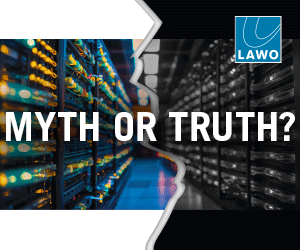In the last two years, the Starz Play team has been working towards shedding its software fat and building agile systems in-house, to take its service to a new level in terms of subscription management and video delivery. In an exclusive interview with Vijaya Cherian, Saleem Bhatti, CTO, and Khaled Benchouche, SVP of Programming and […]

In the last two years, the Starz Play team has been working towards shedding its software fat and building agile systems in-house, to take its service to a new level in terms of subscription management and video delivery. In an exclusive interview with Vijaya Cherian, Saleem Bhatti, CTO, and Khaled Benchouche, SVP of Programming and Acquisitions at Starz Play, discuss how the September launch of Starz Play Connect, a next-generation platform, will raise the company’s profile in the market
This month, streaming service provider Starz Play has embarked on a rich and sophisticated technical journey that now has several broadcasters and IPTV players knocking on its doors to sublicense its new platform. The new launch, Starz Play Connect, is the culmination of several years of Starz Plays efforts to develop different parts of a complicated jigsaw to enable a multitude of payment and delivery features on multiple levels. The result is a rich next-generation platform that goes beyond anything available in the market today by connecting a whole suite of applications built entirely in-house.
The man spearheading the technical venture at Starz Play since its launch is Chief Technology Officer Saleem Bhatti, an ex-HBO techie with more than 12 years of experience prior to that, tinkering with software development in video conferencing in some of the worlds most challenging and exciting markets, such as the US, Europe and China.
This is the result of years of experience developing software for emerging markets. Only a Netflix or an Amazon and some areas of HBO will probably give you that, and now we have gone beyond what even they have done so far, says Bhatti.
What we had before and still do, albeit in the phase-out process, were disconnected and disparate systems that were put together for a quick market launch in 2015. We used to previously employ cloud-based SaaS (software as a service) vendors instead of building out our own software. The basic premise of SaaS is that they can help you get work done faster without the need to invest in the environment, i.e. the software, servers and data centres.
By building the software ourselves now, we have replaced the generic SaaS feature-rich applications that we were paying too much for and didnt necessarily utilise to their full capacity. Now we know what our needs are, so we have built the software and the services that we will actually use.
In the MENA region, Starz Plays subscription numbers have grown by leaps and bounds. While Netflix had just 137,000 MENA subscribers at the end of 2016, according to estimates by analytics firm IHS Markit, Starz Plays CEO Maaz Sheikh claims the platform presently has a whopping 700,000 subscribers in the Middle East, where the VOD subscription numbers are somewhere between the two and three million mark.
Apart from having premium content, Bhatti believes the secret to the success of any OTT SVOD business lies in building two other pillars: video delivery and collections.
You exist to serve flawless video 24/7/365, and to collect subscription fees without being a burden on the user experience.
This is where Connect comes in. It brings together a suite of applications that enable both pillars to function smoothly. Under the hood, Connect is actually a CDN (content delivery network) that includes not just the software and the servers needed for video delivery, but also the peering connections with operators/ISPs. It is built on a modern engineering environment that powers the software development engine for the company. The companys software services and platforms have been built as a portable, highly available set of applications that can be globally deployed on cloud infrastructure or in-house private domains.
Launching the service in a new region is like screwing in a light bulb and then flicking the switch. The platform is integrated with many carriers and methods of payments, such as Apple, Google, du, Etisalat, STC, Ooredoo Kuwait, Ooredoo Tunisia, Ooredoo Algeria, Maroc Telecom, Vodafone Egypt, Orange Jordan and Viva Bahrain, through the subscription engine that manages payment lifecycles for hundreds of thousands of end users, says Bhatti.
As part of this technological advancement, Starz Play has also switched to a microservices approach to increase efficiencies in its SDLC (systems development lifecycle).
We started to dial in on business goals as milestones of achievement and removed unnecessary software bloat that increases maintainability when creating integrations with carriers. Simply put, we optimised our software, moving away from vendor-driven platforms to our own software, therefore inherently increasing operational performance.
All operators were moved off the companys centrally managed integration platform and onto their own individual integration.
Previously, if we made any changes to operator integrations, wed have to ensure uniformity across the entire platform. That meant unnecessary regression QA testing. Now, with microservices, we do the QA for a smaller set of software updates, therefore making the process more agile with faster time to market.
Migrating from an old monolith integration platform to a microservice per carrier has helped Starz Play scale up smaller components of a software application during peak times. This ensures a smoother customer experience.
This approach also allows for the management of carrier partner integrations at a granular level, instead of dealing with all carriers at the same time, as with the monolith platform before, explains Bhatti.
The micro-services approach has had several uses on multiple levels. It has helped the team build system components such as a recommendation engine, user management, operator integrations, short messaging centre and user events management, while also helping deliver new features such as continue watching, temporary downloads and content censoring.
One of the principal benefits of choosing microservices as a strategy was that they inherently reside in virtualised environments, meaning that integrations amongst other software code are mobile and easily transported, explains Bhatti.
This applies to the subscription management piece built within our microservices approach as well. It allows us to virtualise our software into packages that can be placed onto servers anywhere outside our own cloud servers (AWS) and onto other clouds (Google, Azure), or inside of ISPs/telcos to run very specific software processes locally. You may call this edge computing or mobile edge computing (MEC). This will become the de facto method of service delivery in the 5G era in the near future.
So what we had before were many software vendors pieced together to deliver our service end-to-end. With Connect, weve built our own software services in a manner that allows them to scale independently of platforms that might be installed later on.
Virtualisation enables Starz Play to embed a billing collections process (software) alongside the API endpoints that form part of the microservice inside a virtualised container.
For the uninitiated, a container is a set of software components embedded into a standard development and deployment package, which comes with hooks into an operating system without having to be tied down to a physical server.
Docker, Kubernetes, Mesosphere, AWS EC2, Rocket et al are a select set of components that make up virtualised environments particular to a microservices approach to software development and deployment, explains Bhatti.
One of the big challenges for an SVOD service is offering a variety of payment opportunities and ensuring it works smoothly to reduce churn. A fraction of a seconds inefficiency can cost the service a subscriber, warns Bhatti.
Starz Play alleviates the network effect by placing the billing collections engine inside the carrier partners network, close to the billing engine.
This ensures our collections requests arent hit by network congestion or suffer time-outs due to latency issues that plague the network infrastructure in MENA. For instance, the old approach used the open internet for processes that were based on Starz Plays cloud SaaS. This meant that it would experience time outs. A time out could mean a microsecond cut in the network while a request has gone out to collect fees from a subscriber, or activating a subscriber because she has money on her account that is collectable, and if those operations dont happen and the services aren’t activated, it causes a negative impact on the customer experience and leads to fast churn. We are talking about losing hundreds or thousands of subscribers from various processes.
The new approach places the same software and processes inside the telco/ISP network, so you dont have to go out onto the internet to communicate. Its all done within the network, where outages are pretty much non-existent. So everyone benefits we dont activate people who havent paid, we dont deactivate people who have paid due to time outs and us deactivating them due to a failed response, etc. This reduces churn and enhances the customer experience. Things like this are critical to SVOD survival.
By virtualising billing collections, a container is placed on a server inside the network. Collections processes for that particular carrier run successfully and without the network delay experienced previously while going over the internet to connect to various end points. Its a more pragmatic billing collections approach, Bhatti says.
The other big pillar is video delivery. In addition to an end-to-end subscriber management platform, Starz Play Connect includes a vast video delivery infrastructure.
Video delivery over a public CDN in the MENA region isnt delivering results that match public CDNs in the US or Europe. A small number of PoPs (points of presence) do not help in distributing video files for streaming that need to reside as close as possible to the end user who consumes them. Public CDNs are investing in more PoPs, but this is slow going and not enough to saturate the region sufficiently to deliver broadcast-like results for video playback. Expectations among customers are high; they want a similar experience to broadcast like playout, without the latency.
Netflix has a similar approach in terms of video delivery, says Bhatti, who is quick to add that it does not have carrier billing integrations with telcos just yet.
The main differentiator for us is that weve been here longer and have that invaluable experience in delivering services even for a year or two longer, because weve used that time to adjust and tinker, he says.
One of the other big features on Starz Play Connect is a content origin server backbone that stores assets through JIT (just-in-time) packaged versions and content caches hosted in strategic locations throughout the region. Starz Play has built a private CDN to augment public CDNs, where congestion is an issue and a lack of PoPs creates latency that contributes to rebuffering.
The benefits are clear: faster time to video playback, clearer routes to access the video directly, as opposed to being routed outside of MENA, which can happen during peak traffic time. We now control our traffic routing directly when not using our supplementary public CDN; we optimise delivery based on our algorithms, explains Bhatti.
To illustrate how the streaming service does things differently, when Starz Play launched its temporary download feature, it cached JIT packaged files on an additional content shield in front of the CDN caching shield, which helped improve the download experience for users.
Public CDNs are not caching streaming content to a high ratio against the library; the process to deliver long-tail titles involved going back to the origin caches too often, which introduces latency in delivery, explains Bhatti.
In addition to everything else, Starz Play has cemented peering agreements with all the leading carriers and ISPs that carry the majority of the video traffic in MENA today. It has relocated cloud DRM servers to reside alongside its Connect platform, to optimise playback start times even further. The company has virtualised containers strategically located inside carrier networks, and now has content caches and billing collection engines inside the last mile.
We are inviting more and more peers to connect with us to ensure a great customer experience on Starz Play. Any telcos that see video traffic on their networks going to Starz Play will want to optimise their customers experience by peering with us, Bhatti adds.
The other element Starz Play has brought in-house is app development. Although at launch it used development agencies to create apps across most of the launch platforms, it eventually brought it all in-house.
We realised that vendor lock-in through the use of embedded proprietary code wasn’t conducive to the agile development approach we had created within other areas of the platform. We have apps on all major platforms, including smartphones, tablets, game consoles and smart TVs. We have teams working on R&D projects that are creating next-generation user interfaces free of impediments, with open source technologies where possible, and utilise this community as opposed to negotiating for proprietary code. We have given ourselves the best possible foundation to grow from our launch period in territories simultaneously.
We have virtualised our entire platform for global deployment. We have secured massive economies of scale with built in multi-tenancy and real separation of data while serving all business models, including TVOD, EST, AVOD and Live.
Starz Play has created something unique in our region. We launched very fast under stealth-like conditions; nobody saw us coming. We brought the cloud and SaaS into play in the MENA region. Weve virtualised select software components as necessary, due to our experience in the field. Weve jettisoned some SaaS in favour of building our software around business contexts that work for our needs, adds Bhatti.
The launch of Connect, and bringing development in-house, reflected technological prowess and vision. What was left was funding.
Last month, Starz Play announced that it had secured more funds, raising a total of $125 million since inception with commitments from leading global industry investors Starz, a Lionsgate company (NYSE: LGF.A, LGF.B); State Street Global Advisors (SSGA), the world’s third largest asset manager with more than $2.4 trillion in assets under management (as of 30 June 2014) and media and technology investment firms SEQ Capital Partners and Delta Partners.
Given the funding to date and the surge in growth in the two years the service has been live, Starz Play has hit the ground running at 700,000 paying subscribers to date. Regardless of how the streaming business pans out in the future, Starz Play is well poised to look at its platform as a revenue model if it begins licensing it to other companies.
Khaled Benchouche – If content is king and technology is queen, distribution is an even higher being.”
There is no doubt that Khaled Benchouche, SVP Programming and Acquisitions at Starz Play, knows the value that content brings to any platform; but he is equally cognisant of the power new technologies and distribution wield in upping subscriber numbers.
If content is king and technology is queen, distribution is an even higher being. If you dont have these three elements, then we cannot offer a first-class service or a great experience to our customers, he says.
He adds that between August 2016 and August 2017, Starz Plays content consumption grew fourfold. While Bhatti has explained how subscription management and distribution have helped bring more subscribers into the Starz Play fold, Bechouche explains the dynamics involved in content acquisition.
When we negotiate with a studio for new movies, we select the whole slate that they will release during the year. We take everything. For library movies, we look for the right mix of adventure, comedy, drama, action and thriller among others. Sometimes, we think of programming stunts like selecting all the movies from, say, Martin Scorsese or Tom Cruise. Based on that, we make the selection from each studio. For series, we look at what engages the customer and give viewers the option to binge watch.
We make these choices based on our research on what is trending in the region, and what people are searching for on Google, Facebook, Twitter and YouTube to watch. We analyse all of the digital sources and social media.
This is how we decided to buy The Flash, for instance, on an exclusive basis because it was trending heavily in Saudi Arabia. We bought Homeland as a box set, which was leading in the UAE. Most important is our first-run series. Through our exclusive platform, we can offer the series at the same time as the US and the UK, with subtitles in Arabic.
In the case of the first-run series, we decide on these right at the script level. Some of our team members read the script, and at various stages, we look at whether it is a worthwhile investment or not.
He adds that several variables influence the content buying process, including dedicated teams that analyse viewing figures and study subscriber profiles.
We look at what content they are watching, when they are playing or pausing, what language they prefer and if they are using subtitles in addition to other variables. With subscription management, we can get an accurate profile of each viewer. Its really important to have all these figures and use technology to provide a better service. Of late, there has been a lot of consumption in comedy, so we will focus on Western comedies.
Bechouche, who played a similar role at HBO, is an Algerian raised in France who is fluent in Arabic, which means he can appreciate Arabic content as well. He has a yearly budget allocation and having acquired significant content from the West and the MENA, he is now looking to tap into the Indian expat population by investing in content from the subcontinent.
We are looking at Bollywood content as well as regional movies. We will first launch with movies and then expand to series and other content.
His biggest challenge is the demographics in the region.
We have so many different segments to cater for Arabic, Western, Indian and many others. To have something for everyone is a big challenge. As a company, we are looking at how to deliver the best quality of service with the infrastructure we have in the region, concludes Benchouche.










































































